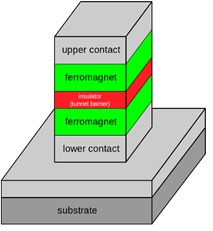The role of ferromagnets and antiferromagnets for spintronic memory applications and their impact in data storage
Spintronic Memory Applications
DOI:
https://doi.org/10.59973/emjsr.6Keywords:
ferromagnets, antiferromagnets, spintronic memory applications, data storage, spintronics, MRAM, giant magnetoresistance (GMR), tunnelling magnetoresistance (TMR)Abstract
The manipulation of multifunctional properties associated with ferromagnetic and antiferromagnetic materials has a great impact in information technology and digital data storage. A relatively recent field called spintronics is a promising alternative technology to store data more efficiently and to overcome obstacles that conventional electronics face. This article provides a small introduction to spintronic devices used for memory applications such as hard disk drives and MRAM, and details ways by which magnetization inside magnetic layers such as ferromagnets can be flipped. The giant magnetoresistance (GMR) effect and its successor in developing memory devices; the tunnelling magnetoresistance (TMR) effect are also discussed since they are key in developing magnetic memory devices.
References
Melvin M. Vopson, The information catastrophe, AIP Advances, 10, 085014 (2020)
Yakout, S.M., Spintronics: Future Technology for New Data Storage and Communication Devices., J Supercond Nov Magn 33, 2557–2580, (2020)
E. E. Fullerton and J. R. Childress, Spintronics, Magnetoresistive Heads, and the Emergence of the Digital World, in Proceedings of the IEEE, vol. 104, no. 10, pp. 1787-1795, (2016)
Willoughby, Arthur, Peter Capper, and Safa O. Kasap. Spintronics for next generation innovative devices. John Wiley & Sons, (2015)
Vinod Kumar Joshi, Spintronics: A contemporary review of emerging electronics devices, Engineering Science and Technology, an International Journal, (2016)
Puebla, J., Kim, J., Kondou, K. et al. Spintronic devices for energy-efficient data storage and energy harvesting. Commun Mater 1, 24 (2020)
Hartmut Zabel, Progress in spintronics, Superlattices and Microstructures, Volume 46, Issue 4, (2009)
Dey, Puja, and Jitendra Nath Roy. Spintronics: Fundamentals and Applications. Springer Nature, 2021
https://en.wikipedia.org/wiki/Giant_magnetoresistance
M. Pinarbasi and A. D. Kent, Perspectives on spintronics technology development: Giant magnetoresistance to spin transfer torque magnetic random access memory, (2022)
https://www.ibm.com/ibm/history/ibm100/us/en/icons/spintronics
Ennen I, Kappe D, Rempel T, Glenske C, Hütten A. Giant Magnetoresistance: Basic Concepts, Microstructure, Magnetic Interactions and Applications. (2016)
Wolfgang Kleemann, Multiferroic and magnetoelectric nanocomposites for data processing, (2017)
https://en.wikipedia.org/wiki/Tunnel_magnetoresistance
Chappert, C., Fert, A. & Van Dau, F. The emergence of spin electronics in data storage. Nature Mater 6, 813–823, (2007)
D.C. Ralph, M.D. Stiles,Spin transfer torques, Journal of Magnetism and Magnetic Materials, Pages 1190-1216, (2008)
T. Kawahara, K. Ito, R. Takemura, H. Ohno, Spin-transfer torque RAM technology: Review and prospect, (2012)
Albert Fert, Frédéric Nguyen Van Dau, Spintronics, from giant magnetoresistance to magnetic skyrmions and topological insulators, (2019)
https://www.ibm.com/ibm/history/ibm100/us/en/icons/racetrack/
Mihai Miron, I., Gaudin, G., Auffret, S. et al., Current-driven spin torque induced by the Rashba effect in a ferromagnetic metal layer, Nature Mater 9, 230–234, (2010)
Liu L, Pai CF, Li Y, Tseng HW, Ralph DC, Buhrman RA, Spin-torque switching with the giant spin Hall effect of tantalum, (2012)

Downloads
Published
Versions
- 2023-07-03 (2)
- 2023-07-03 (1)
How to Cite
Issue
Section
License
Copyright (c) 2023 Marinos Ioannou

This work is licensed under a Creative Commons Attribution 4.0 International License.














